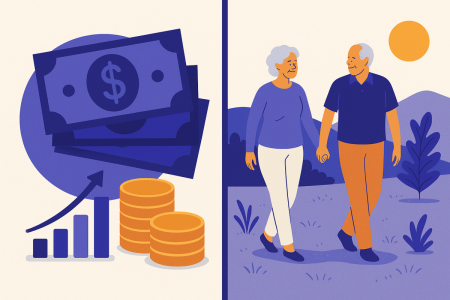Don’t let your super outlast you! Aussie seniors urged to spend (and save) wisely
- Replies 0
Retirement should be a time to enjoy life, but many Australians in their 60s and 70s are finding themselves torn between saving every cent and actually living it up. With longer lifespans and complex pension rules, it’s no wonder almost 80% of retirees say retirement planning feels complicated.
Experts warn that some retirees end up hoarding their nest eggs and regretting it later, while others fall into traps that drain their savings. S, how can seniors get the best of both worlds – securing their finances and enjoying their golden years?
A good first step is to know your super. Log into myGov and link your ATO super account to see all your funds in one place. This digital dashboard shows all your superannuation balances and even any “lost” or forgotten accounts.
Take time to comb through the details: check if your account-based pension has room under the transfer balance cap, and get familiar with your beneficiaries. Remember to update your beneficiary nomination – if you don’t have a binding or reversionary nomination, your super trustee could end up directing your savings in ways you wouldn’t have chosen.
Too often retirees stick with the same fund for decades, even as hidden fees and subpar returns nibble away at their savings. It pays to compare your super fund (or funds) with others – switch if you find a better deal. Even account-based pensions can be rolled over to a new fund for potentially better returns, though be cautious with very old pensions (started before 2015) as closing those accounts can affect your Age Pension or aged care fees.
And if you have more than one super account, consolidate them unless there’s a good reason to keep separate accounts. Fewer accounts mean less paperwork and usually lower fees overall.
Once you’re happy with your fund and fees, look at boosting your balance tax-efficiently. For example, if you have spare cash, consider a tax-deductible contribution. Many retirees in their 60s who still work part-time end up making voluntary super contributions just to save on tax. (The concessional cap is $30,000 a year now, and unused cap space can be carried forward if your total super was under $500,000 at last 30 June.)
If you’ve recently sold an investment or inherited a lump sum, topping up your super could cut your tax bill and funnel more money into a low-tax environment. By age 75 you can no longer make regular deductible contributions (unless they are from downsizer amounts), so some people even do a little “back-to-work” stint to qualify for the work test and make one last jump in.
For retirees who own a family home, downsizer contributions are another big lever. Sell the family home (or are planning to), and singles over 55 can pump up to $300,000 into super (couples $600,000 total) from the sale proceeds. This isn’t a tax deduction – it’s after-tax money – but once inside super it grows at just 15% tax (or 0% in retirement phase), and it gets money into super even if you’re over 75 (when normal contributions stop).
Downsizing can turbocharge your super without hitting your savings caps, so talk to a financial planner about timing a sale and contribution before you move on.
Once you’ve got money in super, choose investments carefully. Many retirees default to “playing it safe” by shifting to cash or fixed income, but this can backfire. You could run out of money if low returns bite into your annual withdrawals. Instead, consider a bucket strategy: keep short-term needs (say 1–2 years of living expenses) in cash or very safe assets, and invest the rest for growth.
That way you won’t panic-sell growth investments during a market dip, yet most of your savings stay in growth assets (like shares or property funds) to get higher returns and beat inflation. If your fund offers it, you could also take direct control of part of your super – many funds let you invest in specific shares or ETFs through a “member-directed” option.
Along with what you invest in, watch your fees. Investment fees (paid to the fund managers) are often hidden in the returns you see, but they add up. Check your fund’s Product Disclosure Statement (PDS) or annual report to see exactly what you’re paying in investment fees. You might find a similar diversified option in the same fund that has a much lower fee – or look for an indexed option that simply tracks a market index, which usually has rock-bottom fees.
And don’t forget insurance: many older Australians find they no longer need insurance (life or income protection) inside super once they retire, so dropping unneeded cover can save fees too.
Above all, get professional advice if you’re unsure. Only about half of retirees feel confident making decisions late in life, and it’s easy to slip up when the rules and options are complicated. An adviser or super consultant can help clarify the pensions rules, rollover options and Age Pension impacts.
As Money magazine advises, consult someone you trust: “You can – and should – optimise those precious years in the lead-up to retirement by developing a solid and robust plan”. (And remember, many super funds offer at least some advice services for members.)
With advice, you can avoid common mistakes like not combining accounts or underutilising the Age Pension, and ensure you have a spending plan that still leaves room for joy.
As one expert bluntly puts it, “Too few retirees are enjoying the benefits of the savings they built up during their working lives”.
On the flip side, beware actions that increase your assessable assets; even overvaluing furniture or vehicles can shave off your pension by hundreds of dollars a year. Advice from finance guru Noel Whittaker: be precise but not extravagant in reporting assets, so you don’t lose pension payments needlessly.
On the other hand, don’t chase risky, exotic investments without understanding them. Stick to what you know, or split between stable income and growth assets based on your risk comfort.
At very least, keep updating your plan: what seemed comfortable at 65 may feel tight at 85. If mental decline is a worry, lock in key decisions early. One survey found retirees are confident in their finances now, but 42% doubt their ability to make those decisions 20 years down the line. Set up a trusted power of attorney if you think you might not want to manage money later on.
If a retirement village sounds tempting, read every clause and budget for those fees. It might be safer to downsize to a smaller home or rent-for-life scheme instead. The lesson: in the quest for community, don’t lose your life savings.
(And remember, moving abroad is an option some consider – one Melbourne couple retired to Bali at 80 to enjoy cheaper living and round-the-clock care, something they couldn’t afford at home.)
Remember, future you might say the same thing the recent Financial Wisdom survey found: one in four Aussies end up wishing they had splurged a little more when they had the chance.
Retirement should ultimately be about living well – financially secure, yes, but also happy and fulfilled. So if you’ve tucked away plenty in super, consider unlocking some of it for life. And if you’re worried about running out, lean on the systems: get age pension, use guaranteed products if they suit you, and get advice to make a solid plan.
So over-60s of Australia – how are you striking that balance? Will you stick tight to your savings or start spending on that dream hobby or trip? How do you plan to enjoy your retirement without losing financial security? Let us know your thoughts on juggling super and lifestyle in the comments below.
Read more: Scrapping super? Controversial proposal sparks uproar
Experts warn that some retirees end up hoarding their nest eggs and regretting it later, while others fall into traps that drain their savings. S, how can seniors get the best of both worlds – securing their finances and enjoying their golden years?
A good first step is to know your super. Log into myGov and link your ATO super account to see all your funds in one place. This digital dashboard shows all your superannuation balances and even any “lost” or forgotten accounts.
Take time to comb through the details: check if your account-based pension has room under the transfer balance cap, and get familiar with your beneficiaries. Remember to update your beneficiary nomination – if you don’t have a binding or reversionary nomination, your super trustee could end up directing your savings in ways you wouldn’t have chosen.
Too often retirees stick with the same fund for decades, even as hidden fees and subpar returns nibble away at their savings. It pays to compare your super fund (or funds) with others – switch if you find a better deal. Even account-based pensions can be rolled over to a new fund for potentially better returns, though be cautious with very old pensions (started before 2015) as closing those accounts can affect your Age Pension or aged care fees.
And if you have more than one super account, consolidate them unless there’s a good reason to keep separate accounts. Fewer accounts mean less paperwork and usually lower fees overall.
Once you’re happy with your fund and fees, look at boosting your balance tax-efficiently. For example, if you have spare cash, consider a tax-deductible contribution. Many retirees in their 60s who still work part-time end up making voluntary super contributions just to save on tax. (The concessional cap is $30,000 a year now, and unused cap space can be carried forward if your total super was under $500,000 at last 30 June.)
If you’ve recently sold an investment or inherited a lump sum, topping up your super could cut your tax bill and funnel more money into a low-tax environment. By age 75 you can no longer make regular deductible contributions (unless they are from downsizer amounts), so some people even do a little “back-to-work” stint to qualify for the work test and make one last jump in.
For retirees who own a family home, downsizer contributions are another big lever. Sell the family home (or are planning to), and singles over 55 can pump up to $300,000 into super (couples $600,000 total) from the sale proceeds. This isn’t a tax deduction – it’s after-tax money – but once inside super it grows at just 15% tax (or 0% in retirement phase), and it gets money into super even if you’re over 75 (when normal contributions stop).
Downsizing can turbocharge your super without hitting your savings caps, so talk to a financial planner about timing a sale and contribution before you move on.
Once you’ve got money in super, choose investments carefully. Many retirees default to “playing it safe” by shifting to cash or fixed income, but this can backfire. You could run out of money if low returns bite into your annual withdrawals. Instead, consider a bucket strategy: keep short-term needs (say 1–2 years of living expenses) in cash or very safe assets, and invest the rest for growth.
That way you won’t panic-sell growth investments during a market dip, yet most of your savings stay in growth assets (like shares or property funds) to get higher returns and beat inflation. If your fund offers it, you could also take direct control of part of your super – many funds let you invest in specific shares or ETFs through a “member-directed” option.
Along with what you invest in, watch your fees. Investment fees (paid to the fund managers) are often hidden in the returns you see, but they add up. Check your fund’s Product Disclosure Statement (PDS) or annual report to see exactly what you’re paying in investment fees. You might find a similar diversified option in the same fund that has a much lower fee – or look for an indexed option that simply tracks a market index, which usually has rock-bottom fees.
And don’t forget insurance: many older Australians find they no longer need insurance (life or income protection) inside super once they retire, so dropping unneeded cover can save fees too.
Above all, get professional advice if you’re unsure. Only about half of retirees feel confident making decisions late in life, and it’s easy to slip up when the rules and options are complicated. An adviser or super consultant can help clarify the pensions rules, rollover options and Age Pension impacts.
As Money magazine advises, consult someone you trust: “You can – and should – optimise those precious years in the lead-up to retirement by developing a solid and robust plan”. (And remember, many super funds offer at least some advice services for members.)
With advice, you can avoid common mistakes like not combining accounts or underutilising the Age Pension, and ensure you have a spending plan that still leaves room for joy.
Common Pitfalls to Avoid
Retirement can feel like walking a financial tightrope: spend too much and you risk running out; save too much and you might miss out on living. Some pitfalls are obvious, others sneak up on you:- Over-conservatism and “regret risk.” Research shows many Aussie retirees become so scared of outliving their savings that they stop themselves from spending on holidays or activities.
As one expert bluntly puts it, “Too few retirees are enjoying the benefits of the savings they built up during their working lives”.
- Not claiming the pension (or mixing it poorly). Many retirees don’t realise the Age Pension is still a big part of the picture. A couple on a full pension effectively enjoys an annual income of about $40,000, which an actuary estimates is worth roughly $1 million in today’s dollars over a lifetime.
On the flip side, beware actions that increase your assessable assets; even overvaluing furniture or vehicles can shave off your pension by hundreds of dollars a year. Advice from finance guru Noel Whittaker: be precise but not extravagant in reporting assets, so you don’t lose pension payments needlessly.
- High fees and poor investment choices. A single digit difference in fees can shave tens of thousands off your balance over retirement. Don’t assume your fund is automatically a good deal just because it’s well-known; actively compare it against low-fee industry funds.
On the other hand, don’t chase risky, exotic investments without understanding them. Stick to what you know, or split between stable income and growth assets based on your risk comfort.
- Ignoring longevity and health costs. People are living longer than ever: a 67-year-old today in Australia can often expect another 20 years of life on average. One-third of retirees admit they thought they’d live shorter than they are. If you outlive your savings, the safety net is usually the Age Pension, but also consider health and aged-care costs.
At very least, keep updating your plan: what seemed comfortable at 65 may feel tight at 85. If mental decline is a worry, lock in key decisions early. One survey found retirees are confident in their finances now, but 42% doubt their ability to make those decisions 20 years down the line. Set up a trusted power of attorney if you think you might not want to manage money later on.
- Retirement village “financial prisons.” Picking where to live in retirement matters – not just your city or suburb, but whether to move into an over-50s village. ABC Investigations recently exposed how many village contracts can gouge residents on exit.
If a retirement village sounds tempting, read every clause and budget for those fees. It might be safer to downsize to a smaller home or rent-for-life scheme instead. The lesson: in the quest for community, don’t lose your life savings.
Life After Work: Enjoying Retirement
Money is part of retirement, but it’s not the whole story. Once your finances are on track, it’s time to think about how you actually want to live. Many Australians in their 60s and 70s are redefining retirement on their own terms:- Travel and adventure. A huge wave of so-called Grey Nomads – retirees towing caravans or camping in motorhomes – has swept the country. At last count over 350,000 RVs toured Australia, most owned by baby-boomers chasing the “big lap” adventure.
(And remember, moving abroad is an option some consider – one Melbourne couple retired to Bali at 80 to enjoy cheaper living and round-the-clock care, something they couldn’t afford at home.)
- Hobbies, volunteering and learning. Retirement opens up all sorts of possibilities. Maybe you’ve always wanted to learn guitar, paint, or write. Local seniors’ centres and libraries often run low-cost courses. Volunteering is another popular choice – many feel purpose helping others. (The parents who moved to Bali continued their community work in a new country.)
- Family and legacy. Half of retirees say they want to pass wealth to kids, but 70% aren’t willing to skimp on their own lifestyle. That’s fine – retirement is about you now. However, it’s still wise to talk about inheritance plans.
- Earning more and working longer. Not everyone wants to stop working cold turkey. If part-time work doesn’t hurt your health, you can keep earning without losing your pension. The government even gave pensioners a one-off boost so they can earn an extra $4,000 this year without pension reduction.
- Mindset shift – live a little. The toughest challenge is often psychological. After decades of the “save save save” message, many retirees find it hard to switch to spending mode. But having a secure base (your super + pension) means you can allow yourself some treats.
Remember, future you might say the same thing the recent Financial Wisdom survey found: one in four Aussies end up wishing they had splurged a little more when they had the chance.
Retirement should ultimately be about living well – financially secure, yes, but also happy and fulfilled. So if you’ve tucked away plenty in super, consider unlocking some of it for life. And if you’re worried about running out, lean on the systems: get age pension, use guaranteed products if they suit you, and get advice to make a solid plan.
So over-60s of Australia – how are you striking that balance? Will you stick tight to your savings or start spending on that dream hobby or trip? How do you plan to enjoy your retirement without losing financial security? Let us know your thoughts on juggling super and lifestyle in the comments below.
Read more: Scrapping super? Controversial proposal sparks uproar










